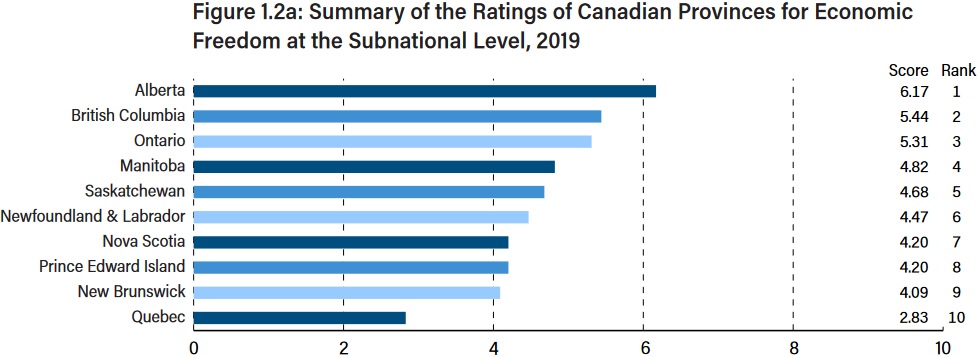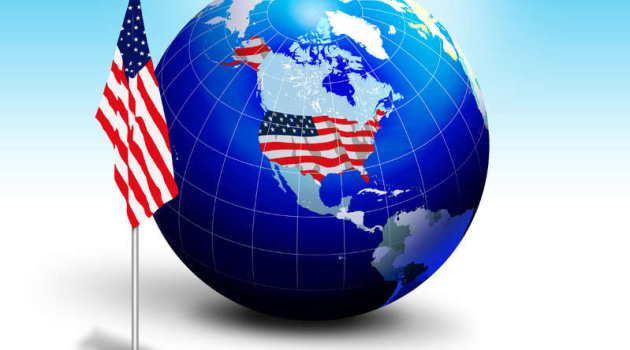If you want to understand why some nations enjoy much stronger economic growth than other nations, the best place to start is the Fraser Institute’s Economic Freedom of the World.
And if you want to understand why some states have more vibrant economies than other states, you should check out the latest edition of the Fraser Institute’s Economic Freedom of North America.
Since most readers are from the United States, I’ll start with a look at the publication’s sub-national index, which shows how American states rank in terms of economic liberty. Unsurprisingly, a bunch of jurisdictions with no income tax are at the top of the list and California and New York are at the bottom.

By the way, the authors (Dean Stansel, José Torra, and Fred McMahon) specifically note that the rankings are based on 2019 data (the latest-available data) and thus “do not capture the effect on economic freedom of COVID-19 and government responses to it.“
With that caveat out of the way, here are some of the findings for the sub-national index (which is where Figure 1.2b from above can be found).
Since the Fraser Institute is based in Canada, they understandably start by looking at Canadian provinces, but you can then read about results for the rest of North America.
For the purpose of comparing jurisdictions within the same country, the subnational indices are the appropriate choice. There is a separate subnational index for each country. In Canada, the most economically free province in 2019 was again Alberta with 6.17, followed by British Columbia with 5.44, and Ontario at 5.31. However, the gap between Alberta and second-place British Columbia continues to shrink, down from 2.30 points in 2014 to 0.73 in 2019. The least free by far was Quebec at 2.83, following New Brunswick at 4.09, and Prince Edward Island and Nova Scotia at 4.20. In the United States, the most economically free state was New Hampshire at 7.83, followed closely by Tennessee at 7.82, Florida at 7.78, Texas at 7.75, and Virginia at 7.59. …In Mexico, the most economically free state was Baja California at 6.01.
Here are the provincial rankings from Canada.
Alberta is the best place for economic growth and Quebec is the worst (by a significant margin).

Here are the some of the findings for the all-government index (which uses a different methodology than the sub-national index mentioned above).
The good news, from the perspective of folks in the U.S., is that most states rank above every other jurisdiction in North America (and the Mexican state all rank at the bottom).
The top jurisdiction is New Hampshire at 8.23, followed by Florida (8.17), Idaho (8.16), and then South Carolina, Utah, and Wyoming tied for fourth (8.15). Alberta is the highest ranking Canadian province, tied for 33rd place with a score of 8.00. The next highest Canadian province is British Columbia in 47th at 7.91. Alberta had spent seven years at the top of the index but fell out of the top spot in the 2018 report (reflecting 2016 data). The highest-ranked Mexican state is Baja California with 6.65, followed by Nayarit (6.62)… Seven of the Canadian provinces are ranked behind all 50 US states.
By the way, here’s some historical context showing that all three nations had their best scores back in the early 2000s (when the “Washington Consensus” for pro-market policy still had some impact.
Historically, average economic freedom in all three countries peaked in 2004 at 7.74 then fell steadily to 7.24 in 2011. Canadian provinces saw the smallest decline, only 0.19, whereas the decline in the United States was 0.51 and, in Mexico, 0.58. Since then average economic freedom in North America has risen slowly to 7.43 but still remains below that peak in 2004. However, economic freedom has increased in the United States and Mexico since 2013. In contrast, in Canada, after an increase in 2014, it has fallen back below its 2013 level.
P.S. If you want some additional historical context, Alberta’s fall from the top (mentioned in the first excerpt) can be partly blamed on the provincial government’s fiscal profligacy when it was collecting a lot of energy-related tax revenue.
P.P.S. I first wrote about Economic Freedom of North America in 2013 and more recently shared commentary about the 2019 and 2020 versions.


